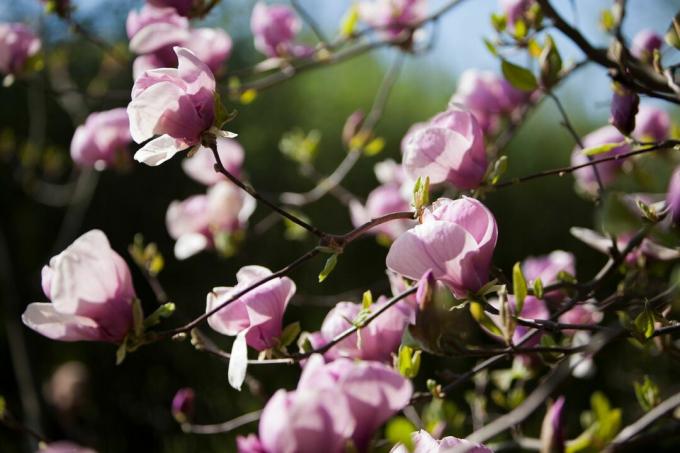The magnolia tree can only blossom if it is in the right place. We show what also needs to be considered when planting a magnolia.

the magnolia (Magnolia) to plant is more complex than the planting of so many other plants. However, a careful approach will save you a lot of effort and will be all the more enjoyable when the magnolia is developing well.
Planting a magnolia is an investment in the future because magnolias get old. In order to provide the plant with the right conditions, there are a few things you should pay attention to and prepare the planting well. Because only then will the valuable tree flourish in all its glory.
contents
- Planting magnolia: the perfect time
- Planting magnolia: the right location
- Procedure for planting a magnolia
- Caring for magnolia after planting
Planting magnolia: the perfect time
The best time to plant a magnolia is during the rest period between October and March. However, that does not mean that you have to hack a hole in the ground when the temperature is below zero and the ground is frozen in January or February. It makes more sense to choose a date in early November or early March, when winter has not yet arrived or is already on the decline.
Planting magnolia: the right location
The location is of course largely a question of the variety. However, there are a few general rules:
- The magnolia likes the sun very much. It doesn't have to be full sun, a little shade over the day doesn't hurt at all. Some species have a tendency to frost cracks in winter when the ground is frozen and the winter sun heats up vigorously. They include, for example, the popular tulip magnolia (Magnolia xsoulangeana). It is better to plant such species in a sunny north-facing location, where temperature fluctuations in winter are significantly lower. One exception is Magnolia siboldiiwho likes shade rather than too much sun.
- The magnolia finds moist earth wonderful. Soils that tend to waterlogging should be provided with a drainage layer when planting.
- A location protected from the wind is right for the magnolia. Some varieties, especially large-flowered magnolias, need a little more wind protection than others.
- Give your magnolia enough space. The plants get quite old and can only develop splendidly if they have enough space available. You should plan at least five to eight square meters for a tree.

Procedure for planting a magnolia
Planting magnolia trees should be approached with caution. So that the plant thrives well, it is worth preparing a suitable starting hole for it. Dig a large planting hole. It should be about twice as high and twice as wide as the root of the plant. This loosens the surrounding soil sufficiently.
Magnolias need a pH between 5.5 and 6.8. The milieu should therefore be in the acidic range. You can do this by placing a sack of peat earth in the planting hole and mixing it with a good part of the excavated material in the hole. Unfortunately, bog soil contains a lot of peat, which is why it tends not to be recommended for environmental reasons.
Now place the root ball in the hole and arrange the whole thing so that the soil mixture is distributed around the root ball. However, do not pile earth around the trunk, because the tree should not be set any deeper than it was previously underground. Then you can press the soil lightly and water it abundantly. Although the magnolia likes to be in the sun on top, it likes it cool and damp at the roots - a thick layer of bark mulch helps. Later, when the magnolia has grown well, a ground cover around the trunk is also suitable as good protection.

Summary planting magnolia:
- Dig a hole twice the size of the root ball
- Mix the excavated hole well with acidic peat earth
- Place the root ball in the hole and fill it with soil mixture
- Never set the tree lower than it was previously planted
- Press down the planted tree lightly and water it well
- Put bark mulch around the plant
Caring for magnolia after planting
After planting, the magnolia does not need any further care. The following year the plant copes well with the nutrients it has received. You do too much harm rather than good. If you planted the plant in a dry autumn, it will of course need water at the beginning - so in this case water every now and then. The same applies to a dry spring.
As soon as the magnolia is a little older, it should be fertilized every spring. Compost or primarily organic long-term fertilizers in organic quality such as ours are suitable for this Plantura organic universal fertilizer outstanding.
More about fertilizing and Cutting magnolias find out here.
